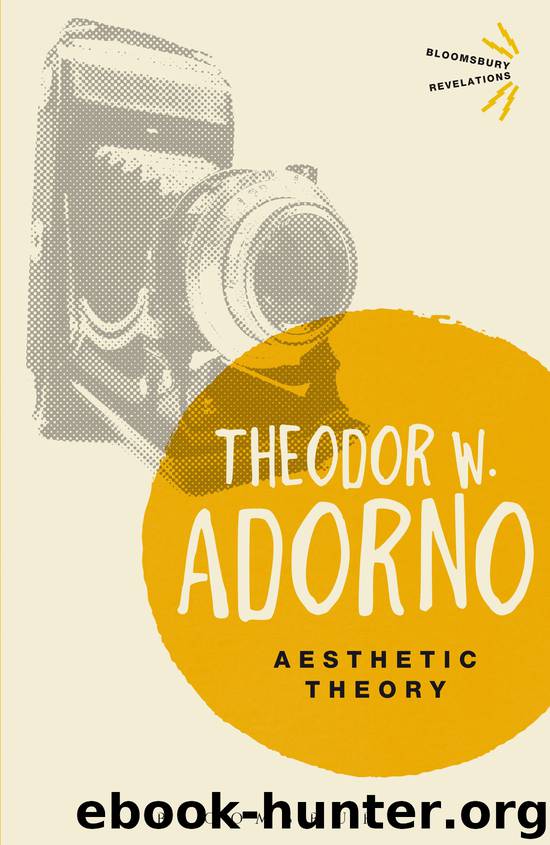Aesthetic Theory by Adorno Theodor W

Author:Adorno, Theodor W.
Language: eng
Format: epub
Publisher: Bloomsbury Publishing
Notes
1 Immanuel Kant, Critique of Judgment, trans. Werner S. Pluhar (Indianapolis, 1987), p. 43.
2 Ibid.
3 Ibid., p. 64.
4 Adorno, Notes to Literature, trans. Shierry Weber Nicholsen, vol. 2 (New York, 1992), p. 163. [Translation amended.—trans.]
5 [“Der Begriff des Ursprünglichen”: The reference to Benjamin has been interpolated here by the translator. See note 7 in “Semblance and Expression.”—trans.]
Chapter 10
Toward a Theory of the Artwork
That the experience of artworks is adequate only as living experience is more than a statement about the relation of the observer to the observed, more than a statement about psychological cathexis as a condition of aesthetic perception. Aesthetic experience becomes living experience only by way of its object, in that instant in which artworks themselves become animate under its gaze. This is George’s symbolist teaching in the poem “The Tapestry,”1 an art poétique that furnishes the title of a volume. Through contemplative immersion the immanent processual quality of the work is set free. By speaking, it becomes something that moves in itself. Whatever in the artifact may be called the unity of its meaning is not static but processual, the enactment of antagonisms that each work necessarily has in itself. Analysis is therefore adequate to the work only if it grasps the relation of its elements to each other processually rather than reducing them analytically to purported fundamental elements. That artworks are not being but a process of becoming can be grasped technologically. Their continuity is demanded teleologically by the particular elements. They are in need of continuity and capable of it by virtue of their incompleteness and, often, by their insignificance. It is as a result of their own constitution that they go over into their other, find continuance in it, want to be extinguished in it, and in their demise determine what follows them. This immanent dynamic is, in a sense, a higher-order element of what artworks are. If anywhere, then it is here that aesthetic experience resembles sexual experience, indeed its culmination. The way the beloved image is transformed in this experience, the way rigidification is unified with what is most intensely alive, effectively makes the experience the incarnate prototype of aesthetic experience. Yet it is not only the individual works that are immanently dynamic; so too is their relation to each other. Art is historical exclusively by way of individual works that have taken shape in themselves, not by their external association, not even through the influence that they purportedly exert over each other. This is why art mocks verbal definition. That whereby art’s existence is constituted is itself dynamic as an attitude toward objectivity that both withdraws from and takes up a stance toward it and in this stance maintains objectivity transformed. Artworks synthesize ununifiable, nonidentical elements that grind away at each other; they truly seek the identity of the identical and the nonidentical processually because even their unity is only an element and not the magical formula of the whole. The processual quality of artworks is constituted in such a fashion
Download
This site does not store any files on its server. We only index and link to content provided by other sites. Please contact the content providers to delete copyright contents if any and email us, we'll remove relevant links or contents immediately.
| Appreciation | Blank Sheet Music |
| Composition | Conducting |
| Exercises | Instruction & Study |
| Lyrics | MIDI, Mixers, etc |
| Philosophy & Social Aspects | Songwriting |
| Techniques | Theory |
| Vocal |
The Goal (Off-Campus #4) by Elle Kennedy(12435)
Kathy Andrews Collection by Kathy Andrews(10521)
Diary of a Player by Brad Paisley(6866)
What Does This Button Do? by Bruce Dickinson(5527)
Assassin’s Fate by Robin Hobb(5238)
Big Little Lies by Liane Moriarty(4881)
Pale Blue Dot by Carl Sagan(4003)
Sticky Fingers by Joe Hagan(3454)
The Heroin Diaries by Nikki Sixx(2932)
The Death of the Heart by Elizabeth Bowen(2902)
Beneath These Shadows by Meghan March(2718)
The Help by Kathryn Stockett(2704)
Confessions of a Video Vixen by Karrine Steffans(2675)
How Music Works by David Byrne(2527)
Jam by Jam (epub)(2489)
Harry Potter 4 - Harry Potter and The Goblet of Fire by J.K.Rowling(2416)
Strange Fascination: David Bowie: The Definitive Story by David Buckley(2368)
Petty: The Biography by Warren Zanes(2238)
Darker Than the Deepest Sea by Trevor Dann(2208)
